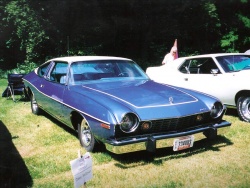 1974 AMC Matador Coupe. Click image to enlarge |
Article and photo by Bill Vance
When Nash and Hudson joined in 1954 to become American Motors Corporation, the Hudson partner brought its heritage of speed to the union. The mighty Hudson Hornets were very strong competitors on the American Automobile Association and National Association for
Stock Car Auto Racing (NASCAR) circuits from 1951 to 1954.
Hudson had a long history of fast cars. In 1916 a Hudson Super Six set a new stock car record of 165 km/h (102.5 mph) on Daytona Beach. The following month it set a 24-hour endurance record at 122 km/h (75.8 mph) on the board track at Sheepshead Bay, New York. It also climbed Pikes Peak, Colorado in a record 18 minutes and 25 seconds, a time that stood for eight years.
Hudson’s new 1932 Essex Terraplane model was another outstanding performer, and at the end of 1933 Hudson held all 50 AAA hillclimb records.
After the 1954 amalgamation Hudson’s cars faded out and Nash designs predominated, although the Hudson nameplate was continued for three years. AMC wasn’t much interested in racing until the late 1960s and early 1970s when various teams, including Roger Penske, campaigned Javelin Pony Cars with some success. They won the Sports Car Club of America Trans-Am championship in 1971.
In 1972 AMC entered NASCAR’s stock car fray with its Matador sedan, hardly considered a performance car. Although its blunt shape was more conducive to family hauling than speedway running it did enjoy some success, including a third place in the 1972 Golden State 400 at Riverside, California, and a win in a 500 mile race there the following year.
But the Matador was handicapped by its brick-like aerodynamics, so AMC rectified this in 1974 by adding the completely restyled aerodynamic Matador coupe. Designed under the direction of
AMC’s talented chief stylist Richard Teague it was a handsome, sleek fastback with a long hood and a mid-level crease running completely around the body.
The headlamps were set back in tunnels and four round tail lights dominated the rear. The styling was a daring about-face for conservative AMC, and Car and Driver magazine called it 1974’s
best styled car. It certainly looked like it was designed with an eye to NASCAR.
Underneath the unit construction coupe was standard AMC fare: coil spring independent front suspension, and coils and a solid axle at the rear. Its 2,896 mm (114 in.) wheelbase was 101.6 mm (4.0 in.) shorter than the sedan’s. Base power was AMC’s sturdy 3.8-litre (232 cu in.) overhead valve, inline six and options ranged all the way up to a 6.6-litre (401 cu in.) V8. Horsepower ratings ran from 100 to 235. Transmissions were a three-speed manual or
three-speed Chrysler-built automatic.
If these power ratings seem low it was because in 1972 manufacturers changed to the more realistic Society of Automotive Engineers net horsepower ratings. These replaced the former rather generous SAE gross ratings. Also, lower compressions ratios required to accommodate lead-free gasoline were sapping power.
A new Matador coupe was prepared by Roger Penske Racing for 1974 and would contest 15 NASCAR races that year. It had mediocre results during most of the season, but did finish all but three of its races. Then in the last meet of the year it finally scored a first in a 500 mile race at its old favourite Riverside, California, in the process setting a track record at 134.963 mph (217 km/h).
The following year was much better. The Matador coupe ran 19 races in 1975, completing the season with 10 top-5 finishes, including three firsts and three seconds.
1976 would be the Matador’s most ambitious year. The factory backed Matador ran all 30 NASCAR races but was plagued with mechanical failures. It notched five top-5 finishes, but no victories, and AMC gave up and withdrew from stock car racing.
The Matador coupe was carried on until 1978 and passed through its five-year life with only juggling of trim and options. Fashion stylist Oleg Cassini was engaged to design optional spruced up trim called the “Oleg Cassini Package” which included copper-coloured instruments, carpets and grille, and a vinyl roof.
The Cassini Package was replaced in 1976 with the Barcelona package which included special fabrics and carpets and wheel inserts. There was also a new grille.
In spite of more standard equipment and the Barcelona II package which included two-tone paint and a vinyl roof with opera windows, Matador sales went into steep decline in 1977. The coupe continued into 1978 but the Matador’s days were over. AMC was now concentrating its efforts on the “fishbowl” Pacer and a revised Hornet now called the Concord.
The Matador coupe had been a brief flirt with glamour, one that also enjoyed some success at racing, but it was too late. AMC was on the ropes and in 1979 would fall into the arms of France’s Renault.








